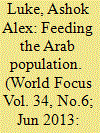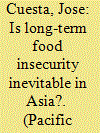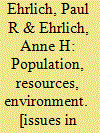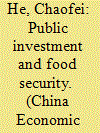|
|
|
Sort Order |
|
|
|
Items / Page
|
|
|
|
|
|
|
| Srl | Item |
| 1 |
ID:
121069


|
|
|
|
|
| Publication |
2013.
|
| Summary/Abstract |
One of the gravest concerns that mankind is facing today is hunger. There are more than 900 million people who go hungry daily around the world and an estimated 25000 people die a day due to hunger and its related causes. Hunger is due to the unavailability of adequate food in sufficient quantities at an affordable price to lead an active and healthy life. Today there is enough food production to feed the global population yet there is a failure in the distribution. Most of the hungry people reside in the developing and the underdeveloped nations.
|
|
|
|
|
|
|
|
|
|
|
|
|
|
|
|
| 2 |
ID:
140097


|
|
|
|
|
| Summary/Abstract |
This article provides a comprehensive overview of the global meat sector and examines significant food processing sub-sectors that are a major contributor to the global economy. Structural changes in global meat production, consumption and trade are analysed using recent Food and Agriculture Organisation statistical databases, in terms of geographic concentration or relocation of production or markets and temporal changes across major geographical regions. The findings indicate significant recent shifts in production, consumption and trade of different kinds of meat. While developing markets still focus on red meat, the developed markets are moving faster towards white meat due to increasing health and environmental concerns among consumers in recent years. The implications of such trends for South Asia are examined, too, and call for further research.
|
|
|
|
|
|
|
|
|
|
|
|
|
|
|
|
| 3 |
ID:
057168


|
|
|
| 4 |
ID:
135066


|
|
|
|
|
| Summary/Abstract |
This article questions two widely accepted claims on long-term food insecurity in Asia, the world's (heterogeneous) region with the largest number of undernourished individuals. The first claim is that food production may not grow as fast as the pace of population growth in Asia, which will reach 5 billion by 2050. The second claim is that an unstoppable emergence of a middle class in Asia will dramatically change the composition of food demand. On the first claim, the region's contribution to high and volatile international food prices is well known, but Asia's potentially positive contributions toward future price uncertainty and productivity growth are much less cited. On the second claim, the changing composition of future food demand in the region will depend on the extent that poverty reduction effectively leads to middle class expansion, which it is not an automatic process, and its extent still remains to be seen. Past evidence teaches us that poverty reduction on its own will not do the job of eradicating hunger, nor will only increasing food production. The jury is still out, but doomsday predictions are not necessarily justified.
|
|
|
|
|
|
|
|
|
|
|
|
|
|
|
|
| 5 |
ID:
118803


|
|
|
|
|
| Publication |
2012.
|
| Summary/Abstract |
A
cross Africa, deep beneath a host
of varied terrains, vast groundwater reserves lie almost untouched.
These aquifers are some 410,000 cubic
miles thick and contain 100 times the
freshwater that exists on the continent's
surface. As Africa's population expands,
these aquifers could prove critical in
increasing food production, reducing
poverty, and adapting to climate change.
|
|
|
|
|
|
|
|
|
|
|
|
|
|
|
|
| 6 |
ID:
091187


|
|
|
|
|
| Publication |
2009.
|
| Summary/Abstract |
A lively discussion of Japanese agriculture is now underway. Deliberations have begun on revising the basic plan for food, agriculture, and rural areas, which is updated every five years, and six members of the cabinet have joined in an agricultural reform group, which has begun studies on creating sturdier agricultural administration in areas from economic and fiscal affairs to local government.
|
|
|
|
|
|
|
|
|
|
|
|
|
|
|
|
| 7 |
ID:
027044


|
|
|
|
|
| Publication |
San Francisco, W.H. Freeman and Company, 1970.
|
| Description |
383p.
|
|
|
|
|
|
|
|
|
|
|
|
Copies: C:1/I:0,R:0,Q:0
Circulation
| Accession# | Call# | Current Location | Status | Policy | Location |
| 005633 | 363.91/EHR 005633 | Main | On Shelf | General | |
|
|
|
|
| 8 |
ID:
170094


|
|
|
|
|
| Summary/Abstract |
This paper examines the causal effect of public investment on food output by exploiting a panel dataset covering a large central government program (Hundred Billion Plan) in China from 2007 to 2013. Based on an event study methodology, we find that public investment significantly increases food output by 4.34%. We find that the sources of the policy effect come mainly through improving productivity, which is driven by increases in fertilizer inputs by households and by the crowding in local government agricultural investments. Further, an ad-hoc benefit-cost analysis shows that the internal return rate (IRR) is 0.23% over a 20-year period. Our results are robust in terms of the assumption of parallel trends, the confounding effect from an alternative policy, the nonrandom selection issue of policy implementation, the inclusion of alternative sets of control variables, the treatment of outliers and the omitted variable biases.
|
|
|
|
|
|
|
|
|
|
|
|
|
|
|
|
| 9 |
ID:
170660


|
|
|
|
|
| Summary/Abstract |
Southeast Asia with its historical concentration of ethnic Chinese remains an important economic hub encouraging cross-disciplinary inquiries on themes relating to businesses. In industrialising Malaysia, there is little research on their capacity to develop tacit knowledge of the founding generation mostly inherited from China, before starting a business in Malaysia. This assessment of four thriving Malaysian Chinese family SMEs in food production evaluates how a new generational change has innovated their traditional food products. Interestingly, tradition may enable these Malaysian Chinese firms to innovate by building on more reliable knowledge and resources, extensively validated over time, and hence reduce development and utilisation costs. The well-trained second and third generations have been innovating tacit knowledge to elicit strong and positive feelings of ‘Chinese’ identity, increasing the value of new products through R&D by embedding past knowledge and facilitating the legitimacy of innovative functionalities and obtaining market acceptance.
|
|
|
|
|
|
|
|
|
|
|
|
|
|
|
|
|
|
|
|
|